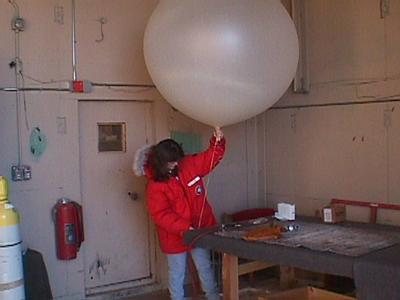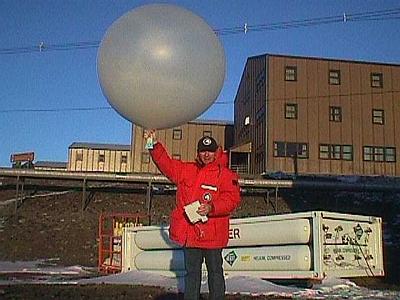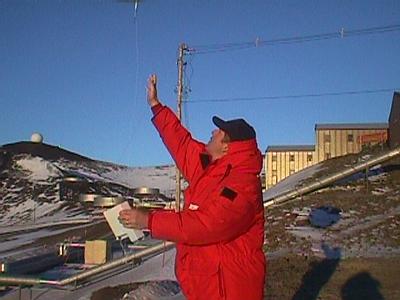2 November, 1999
The weather continues to be the story here. It was pretty nice this morning
but this afternoon the snow started and the wind began to blow. A strong
pressure gradient across the Ross Iceshelf was causing gusty surface winds.
Skies remained mostly cloudy across the area. Flights from Christchurch and
to South Pole were cancelled. McMurdo is a bit crowded right now. Many
people headed to the South Pole for the summer are stuck here because of the
weather. Many of the groups going to field camps are like-wise stuck in
Mactown. The lines at supper are quite long and the dining room is crowded.
With weather being such a critical issue in Antarctica, you can well imagine
that the Weather Forecasting Office in McMurdo, or MacWeather, is a pretty
busy place. I went to visit MacWeather the other day to see how the business
of forecasting weather here differs from the weather offices back home. The
first thing you realize is that the forecasters here have much fewer tools
to work with then back in the states. First there is data. If you look at a
typical weather map of the US (You can get a good one at
http://www.comet.ucar.edu/dstreme/.) it shows hundreds of weather reporting
stations and this represents only a fraction of the stations that are
reporting data. In Antarctica, there are very few reporting stations and
they may be hundreds of miles apart. The University of Wisconsin maintains a
network of about 40 automated weather observing stations around the
continent. You can see the locations of the sites at
http://uwamrc.ssec.wisc.edu/aws/AntAWS.gif and you can get current
temperatures around the continent at
http://uwamrc.ssec.wisc.edu/~amrc/AWSANT.GIF. In addition there are 30
occupied sites that operate the entire year in Antarctica. Most of these are
located on the coast and very few in the interior of the continent.
MacWeather relies heavily on observations made by scientific teams in the
field. I attended a briefing for field teams conducted by Ted, the head
weather observer at MacWeather. He taught the field teams how to estimate
cloud cover, cloud heights, wind speed and wind direction. Not only is this
information vital to help MacWeather make better forecasts, it is also
important for flights going out to pick up the field teams.
There is a weather satellite image of Antarctica available to the
forecasters. It comes from a polar orbiting satellite that passes over the
continent. You can view the latest image at
http://uwamrc.ssec.wisc.edu/~amrc/COMP.GIF. You will notice when you view
the image that there is a large black space where there is no image. Due to
the way polar orbiting satellites cross Antarctica, there is a time period
for any location where there is no image available. The weather satellites
that cover North America are geo-stationary satellites. They stay in the
same position over a point on the Earth giving continuous coverage. For
McMurdo the blackout is about 6 hours meaning the forecasters at MacWeather
do not have a satellite image for one-fourth of the day.
There is no weather RADAR in McMurdo. National Weather Service
Offices like the one in Green Bay, Wisconsin have sophisticated Doppler
Radar at their disposal. Upper air data from balloon soundings are critical
for forecasters to understand what is happening in the atmosphere above the
surface. In the United States there are about 50 balloon launching sites. At
these sites, weather balloons are launched twice a day, every day. These
launches allow weather forecasting computers to develop models of how the
atmosphere is behaving and help forecasters make better forecasts. In the
entire continent of Antarctica there are a total of 9 balloon launch sites.
I had an opportunity to help with a weather balloon launch at MacWeather.
(See picture below.) If you would life to view the latest data from the
McMurdo balloon sounding, go to
http://uwamrc.ssec.wisc.edu/~amrc/SKEWTMCM.GIF.
Despite this lack of information, MacWeather is responsible for
making weather forecasts for plane flights to New Zealand, South Pole and
other locations around the continent. Ted made a great analogy that
illustrated how difficult their job is. He said forecasting for flights
across Antarctica is like knowing only the weather observations in Kansas
City and Seattle and trying to forecast the weather for a flight from Miami
to Alaska! The forecasters have to rely heavily on previous experience and
the observations made by pilots and people in the field. Despite their best
efforts, however, weather in Antarctica can change without warning. It is
important that each person keeps watching the sky and be his or her own
weather forecaster.
Why is Antarctica so cold? This is a question I want you to think
about and I will talk about it tomorrow in my journal.

Joanne prepares the weather balloon by filing it with helium.

Here I am holding the balloon ready to launch. I am holding the radiosonde instrument package in my left hand.

And it's gone............

The McMurdo Weather Office, center of weather forecasting in Antarctica.

Board showing planned flights of C141 and C130 aircraft around the continent.
Contact the TEA in the field at
.
If you cannot connect through your browser, copy the
TEA's e-mail address in the "To:" line of
your favorite e-mail package.
|
